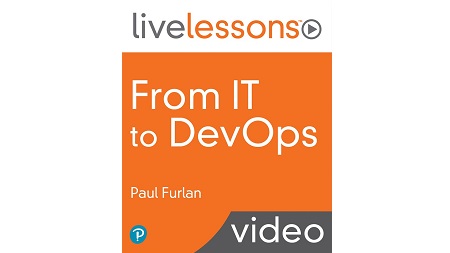
English | MP4 | AVC 1280×720 | AAC 44KHz 2ch | 8h 01m | 7.73 GB
DevOps is a set of practices that works to automate and integrate the processes between software development and IT teams so they can build, test, and release software faster and more reliably. These days, it is imperative for engineers in the IT industry to understand what DevOps is and how it works so they can keep their skills and knowledge up to date. This LiveLessons does just that!
The days of specializing in just one technology are obsolete. People and teams involved in the whole DevOps cycle are now (or soon will be) cross-functional, where developers can add operations knowledge and operations engineers can incorporate development and scripting knowledge in order to help the entire team output better products faster. In this video training, Paul Furlan covers what you need to skill up and succeed.
With this LiveLessons course, IT Pros will have the chance to see how a product can be developed by applying DevOps to the entire process, and they will also have hands-on labs to test concepts and learn.
What You Will Learn
- Build a complete product from ideation through deployment with Gitlab
- Deploy the application using a DevOps approach with Gitlab Continuous Deployment pipelines.
- Learn how each phase of the DevOps cycle works.
- Perform testing on your application to detect bugs and make sure all is working as expected.
- Unit test and load test to detect bugs, security vulnerabilities, performance, and more.
- Perform static code analysis.
- Explore the most popular application packager managers, such as Maven, NPM, NuGet, and PyPi.
Table of Contents
Introduction
Lesson 1: Start with an Idea
Learning objectives
1.1 Learn about software development lifecycle approaches
1.2 Learn about the Agile Principles and the Agile Manifesto
1.3 Explore Agile project management
1.4 Lab a. Set the stage: Boards: Plan a small project using milestones, tasks, and issues
1.5 Lab b. Solution: Boards
Lesson 2: Understand What DevOps Is
Learning objectives
2.1 Understand the foundations of DevOps
2.2 Learn how DevOps can be implemented
2.3 Break down the DevOps lifecycle
Lesson 3: Understand Version Control
Learning objectives
3.1 Understand the need for VCS/SCM
3.2 Explore the git workflow
3.3 Learn about semantic versioning
3.4 Learn about the most useful git commands
3.5 Lab a. Set the stage: Install and use git
3.6 Lab b. Solution: Install and use git
3.7 Lab c. Solution: Use git with a remote repository
Lesson 4: Create a CI/CD Pipeline
Learning objectives
4.1 Review the most popular CI/CD tools
4.2 Understand YAML files
4.3 Learn about the Gitlab CI/CD pipeline
4.4 Utilize artifacts
4.5 Learn about runners
4.6 Lab a. Set the stage: Install a runner and run a CI/CD pipeline with artifacts
4.7 Lab b. Solution: Install a Gitlab runner
4.8 Lab c. Solution: Create a CI/CD pipeline
4.9 Lab d. Solution: Create artifacts
Lesson 5: Set Up Continuous Integration
Learning objectives
5.1 Learn about testing in the continuous integration phase
5.2 Learn about unit testing
5.3 Learn about static application security testing (SAST)
5.4 Lab a. Set the stage: Test your code
5.5 Lab b. Solution: Prepare your application
5.6 Lab c. Solution: Test your application
Lesson 6: Create and Upload Packages to the Registry
Learning objectives
6.1 Understand packages
6.2 Learn about the package registry
6.3 Learn about the container registry
6.4 Lab a. Set the stage: Push packages and containers to the registry
6.5 Lab b. Solution: Create a package locally and push it to the registry
6.6 Lab c. Create a package in a pipeline job and push it to the registry
6.7 Lab d. Creating our dockerfile
6.8 Lab e. Setting up our pipeline
6.9 Lab f. Running and reviewing our container job
6.10 Lab g. Package a Maven and NPM project
Lesson 7: Test Your Application
Learning objectives
7.1 Learn about automated testing
7.2 Learn about application testing
7.3 Lab a. Set the stage: Application testing automation
7.4 Lab b. Solution: Deploy your application for testing
7.5 Lab c. Solution: Run application testing
7.6 Lab d. Performance test
7.7 Lab e. Reviewing our tests
Lesson 8: Understand Deployment Strategies
Learning objectives
8.1 Review the different deployment environments
8.2 Understand continuous delivery and continuous deployment
8.3 Understand the different deployment strategies
Lesson 9: Deploy Your Application
Learning objectives
9.1 Learn about cloud infrastructure
9.2 Learn about infrastructure as code
9.3 Learn about configuration management
9.4 Understand container orchestration
9.5 Functions and microservices
9.6 Review monitoring and logging
9.7 Lab a: Set the stage: Deploy to production
9.8 Lab b: Solution: Deploy to production
Summary
Resolve the captcha to access the links!